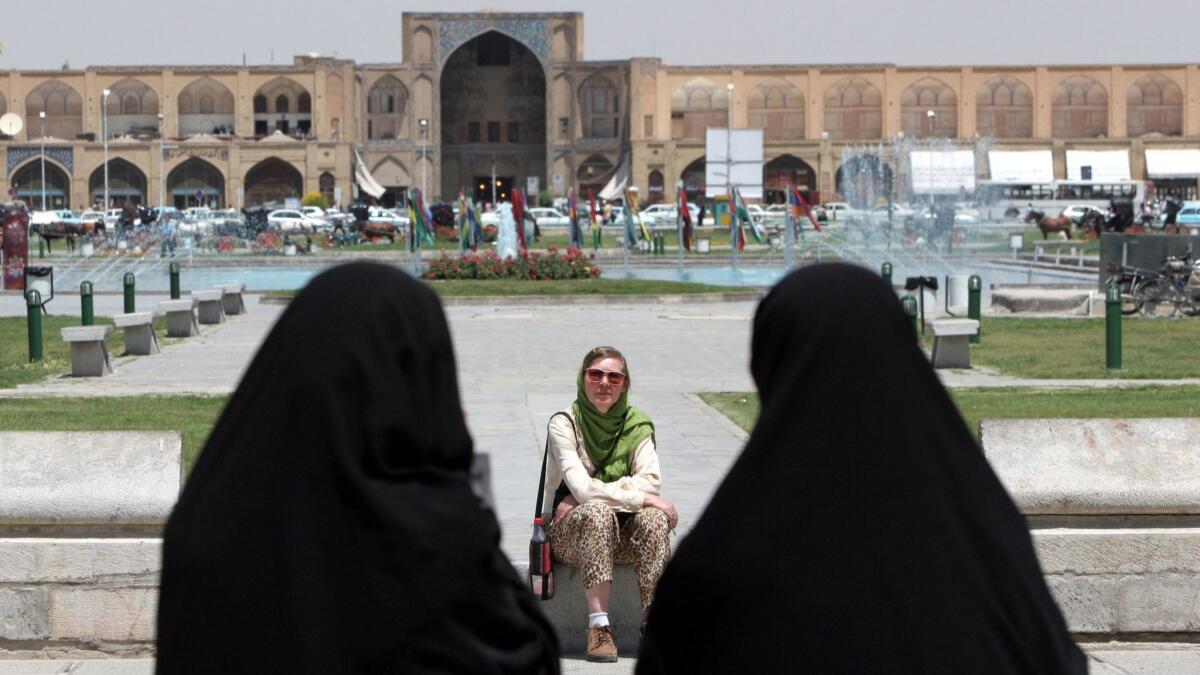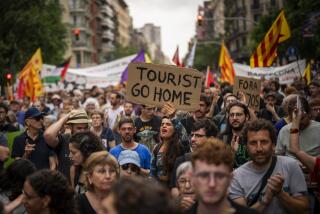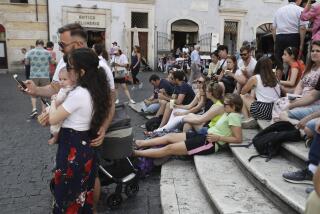Iran had courted Western tourists. After sanctions, it’s turning to neighbors

Reporting from Tehran — Kristina Nemeth was one of the U.S. travelers curious enough about Iran to make the journey.
She went in 2014, part of an influx of Western travelers to the Islamic Republic as negotiations surrounding a landmark nuclear pact pulled the country out of international isolation.
The San Francisco resident recalls an elderly shopkeeper coming out from behind his booth in a Tehran bazaar as she passed. He reached for her hand and spoke: “Americans are welcome in Iran.”
After the multi-nation deal’s signing in 2015, Iran’s tourism industry took off. European airlines resumed flights and international businesses, including hotel chains, sought deals. Iranian officials set the 10-year goal of boosting foreign arrivals fivefold to 20 million.
Then came the U.S. presidential election.
President Trump, who had excoriated Iran on the campaign trail, pulled the U.S. out of the nuclear pact. Sanctions kept Western airlines from operating in the country and limited transactions with Iran’s central bank.
Hostile rhetoric between the nations increased. And travel to Iran from the West, particularly the U.S., plummeted.
Now Iran has pivoted to a new strategy: To keep its tourism industry alive, and perhaps to make it grow, the country is turning to its neighbors. Tehran has announced projects to boost infrastructure and ease red tape in an effort to draw more visitors from countries in the region.
“When the infrastructures are finished, income from tourism will replace oil revenues,” claimed Iranian Vice President Ali Asghar Mounesan, who heads the nation’s tourism organization.
The shift from Western tourism pleases Iran’s hard-liners, who they say they don’t want the “cultural invasion” anyway. But experts say sanctions have slowed development of the nation’s tourism industry, and Iranian tour guides still long for well-paying Westerners.

Boosting religious tourism
Since last year, Iran has announced numerous projects as part of its focus on drawing tourists from around the region.
It added Egypt, Azerbaijan, Syria, Turkey, Lebanon and Georgia to the list of countries whose nationals can get visas on arrival. Plans are in the works to revive passenger sea lines, including routes between Iran and Saudi Arabia, Bahrain, Qatar and Oman.
Officials have announced plans to build a railway that starts in southwestern Iran’s Khuzestan province, travels west through Iraq and ends at the Syrian port city of Latakia. The three nations agreed to work together to develop the system in hopes of boosting religious tourism.
For now, some tourists from the region are taking advantage of Iran’s relative affordability after the devaluation of its currency, the rial, following sanctions.
“Iran is an inexpensive country for us,” said Amineh Pasha, a Turkish tourist, “and we are interested in historic sites in Tehran, Esfahan and Shiraz.”
Pasha, 54, visited Iran in April on an organized tour.
“We are here out of curiosity. We want to see historic monuments and landmarks and taste national meals,” she said as she bought a snack near Tehran’s Imam Khomeini Square. “We can communicate with Iranian local Turks and people are hospitable to us. We feel quite comfortable.”
Seyyed Amir Akghaseer, an Iraqi, brought his father to Tehran not for the religious sites, but for the doctors. The 24-year-old Shiite Muslim felt Iran’s affordable prices, coupled with its experienced medical providers of similar religious backgrounds, made it a good fit for his father, who is battling stomach cancer.
“We are Shiites and feel at home,” he said.
Building a tourism infrastructure
“Iran is still in its initial stage of developing its tourism infrastructure, but they have been paying attention to it as an economic agenda,” said Xu Jing of the United Nations World Tourism Organization.
As Iran started climbing out of isolation during nuclear talks with the five permanent members of the U.N. Security Council plus Germany, more Westerners began visiting the Islamic Republic and the tourism industry appeared to blossom.
Foreign travel to Iran grew to 5.2 million arrivals in 2015, up from 4 million the year before. The number of U.S. tourists reached 5,308 in 2016, up 62% from two years before, according to the U.N. World Tourism Organization.
But experts say renewed U.S. pressure on Iran has hindered the industry from growing as fast as it could and has hurt businesses in the short term.
Trump administration designates Iran’s Revolutionary Guard a terrorist group »
Foreign arrivals to Iran in 2017 fell to 4.8 million and the number of U.S. tourists to 3,728, according to the U.N. agency.
“Sanctions have decreased international travel and air connectivity,” said Xu of the tourism organization. “It’s been preventing Iran from developing its tourism industry to what it deserves to be.”
Dearth of well-paying Westerners
“We used to have 25 people in our tour groups once the nuclear deal was signed,” said Tehran-based tour guide Parnia Porpezeshk, 59. “Now the same group consists of 10 or fewer.”
Porpezeshk has worked as an English-speaking guide in Iran for more than 24 years. Now months go by when she has no tours, she said, and she’s taken up tutoring and translation.
“I can’t rely on tours as a source of monthly income anymore,” she said.
Ali Sadrnia, a member of the Iran Tourist Guides Assn., said there has been an increase in the number of Shiite visitors from countries near Iran. But Western tourists, he said, spend more money.
“West European or North American tourists spend anywhere from $2,500 to $3,000 for hotel, food and travel inside Iran,” he said.
Tour guide Morteza Safavi Naeini said the escalation in tensions has hurt Iran’s image in the world.
If it weren’t for American tourists sharing their positive experience in Iran, Naeini said, he fears he’d be without a job.
“Social media and the feedback from tourists who visit Iran upgrade our image,” Naeini said.
The 39-year-old now depends on former customers to encourage people to visit. “I have one tour a month,” he said.
Iranian officials deny sanctions are hurting tourism
Iranian officials insist U.S. sanctions have not hurt the country’s tourism industry. The numbers they cite vary.
Moheb Khodaei, deputy head of Iran’s Cultural Heritage, Handicrafts and Tourism Organization, said at least 5.2 million foreign tourists visited Iran in the first eight months of 2018, according to state-run television.
Last month, Vali Teymouri, an official with the organization, told the Islamic Republic News Agency that there had been 7 million foreign arrivals during the Iranian calendar year that ended March 20.
“The number of foreign tourists visiting Iran has been unprecedented,” Teymouri told the state news agency.
The U.N. World Tourism Organization has not released numbers for 2018.
Good riddance, conservative factions say
Some conservative factions in Iran say they don’t want Western tourists to visit. Conservative analysts and hard-liners in Iran’s intelligence and security apparatus view U.S. tourists as part a Western “cultural invasion” that seek to get rid of the Islamic Republic.
The conservatives have welcomed the decision to boost Iran’s tourism partnership with its neighbors; they view the move as a way to demonstrate that Iran doesn’t need to depend on the West.
Mohammed Eimani, a conservative analyst based in Tehran, wrote an op-ed in January in the Kayhan newspaper — the mouthpiece of Supreme Leader Ayatollah Ali Khamenei — that said the decrease in the number of Western travelers offers an opportunity to encourage people from Iraq, Turkey and Azerbaijan to visit Iran.
“Our diplomats can talk as much as they think is necessary with the European Union and other Western countries,” Eimani wrote. “But we must not trust them at all, and we must rely on our Islamic Revolution.”
Special correspondent Mostaghim reported from Tehran and Times staff writer Etehad from Los Angeles.
More to Read
Sign up for Essential California
The most important California stories and recommendations in your inbox every morning.
You may occasionally receive promotional content from the Los Angeles Times.











